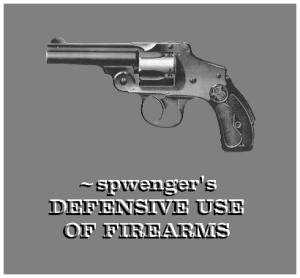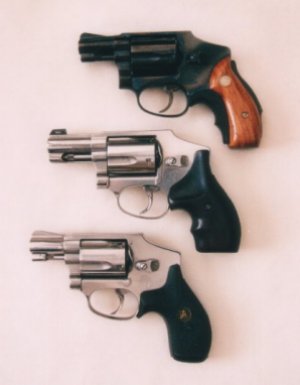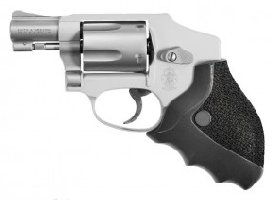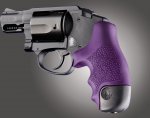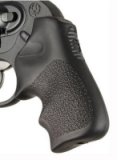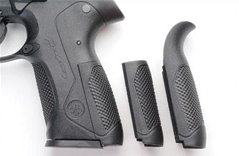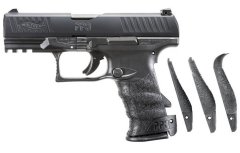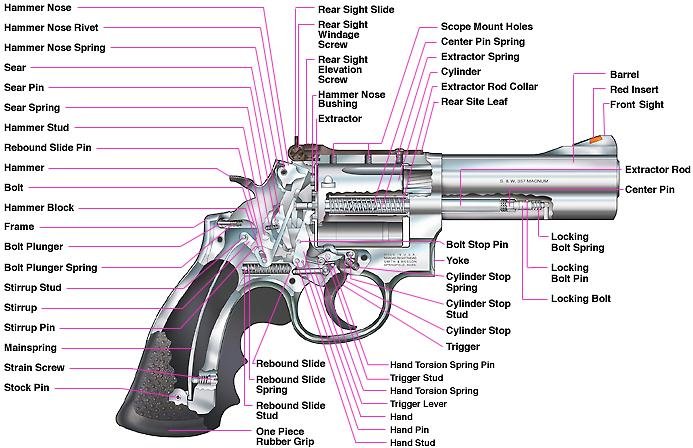- The two key issues with speedloaders are choice of type and how to carry them.
- There are two basic types of speedloader - twist-release and push-release. The choice is somewhat like a man's choice
between briefs and boxers - folks tend to fall into two camps and to adhere strongly to their preferences. Admittedly, I
was trained with twist-release loaders - specifically HKS brand - and am most familiar with and partial to those.
- Twist-release loaders are pretty simple. The body has openings for the cartridges, appropriately spaced so that they
will align them with the chambers of the revolver for which the loader is intended. A knob turns a "star" clear of the
openings for insertion of the rear of the cartridges, then turns it in the opposite direction, to engage the rims. When
it's time to release the cartridges, the knob is turned back. On HKS loaders, the knob turns clockwise to accept and to
release the cartridges and counter-clockwise to secure them. On the twist-release Pachmayr and 5 Star loaders, it's the
opposite.
- At the expense of a longer length, the Speed Beez speedloader operates very much like a twist-release loader except that
rather than twisting the knob, it is pressed to release the cartridges. One review, however, suggests that
this design may not reliably retain the cartridges if dropped.
- A significant concern with speedloaders is the potential for an ergonomically shaped grip stock to interfere with the
optimal alignment of the loader with the cylinder. This can be an issue even when the grip is shaped with a so-called
speedloader clearance. Pachmayr uses a rounded hexagonal shape and 5 Star uses a scalloped shape to minimize that
potential problem.
- Some people dislike the fact that twist-release loaders depend on gravity to seat the cartridges in the chambers. While I
recognize the potential for the chambers to get a bit "sticky" after a few loaded cylinders have been fired, I see that
as more of an issue in a match or in training than in an actual gunfight. I prefer to look at the other side of the coin.
The ability to release the cartridges without having all of them already partially chambered offers a few options:
- Cartridges whose bullets don't present a rounded ogive or taper, allowing easy, simultaneous alignment with all the
chambers - typically low-recoil loads with target-style wadcutter bullets or Federal's similarly contoured +P HST Micro
load - can still be loaded from a speedloader by indexing two of them at the outer edges of two chambers and twisting the
knob.
- When revolvers ruled the roost, some officers who carried a K-frame S&W revolver in the duty holster found that, in a
pinch, they could use the same technique to reload a backup D-frame Colt revolver (e.g., Detective Special or Cobra),
with its slightly smaller cylinder. I'm under the impression that this also applies to twist-release loaders sized for
the five-shot S&W J-frame and Ruger SP101 revolvers to reload Ruger's LCR/LCRx revolvers, with their slightly smaller
cylinders, and vice versa.
- In fact, this last technique can even be used to reload - at least partially - a five-shot J-frame revolver with the
loader for a six-shot K-frame revolver. With no intervening practice, I demonstrate this from time to time. I can usually
get four of the six rounds chambered and, on a good day, five of them.
- (Inasmuch as I've got some photos of the process of a normal reload with an HKS loader, they've been posted on a separate page.)
- Push-release loaders require the cartridges to be inserted far enough into their chambers to depress the release button
at the center of the body of the loader. The push-release, German-made SL Variant - no longer available in the US - has
its body scalloped, to reduce interference with grip panels. This feature seems to have been incorporated into the
relatively new QuickLoad speedloaders. Some users who prefer the push-release concept have found it necessary to deepen
the speedloader clearance on the left side of the grip, in order to use the loaders with round bodies smoothly.
- At that, Safariland's more compact Comp II loaders still depend on gravity - or finger pressure - to finish seating the
rounds. Others, such as Safariland's Comp III loaders, which use a spring to drive the rounds out of the body, add a bit
more bulk on top to house the spring mechanism.
- Speaking of gravity, reloading a revolver generally requires the muzzle to be pointed at least partway below horizontal or
the cartridges will start sliding out before the action can be closed. That's just part of the price of using a revolver.
Of course, as mentioned above, a faster alternative that is not dependent on position is a so-called "New York reload" -
transitioning to a second revolver.
- Speaking further of gravity, in a fight, the loader itself is expendable once the new rounds are chambered. Whichever
type of loader is used, once it's performed its job, it is simply released so that that hand can reacquire the firing
grip and the action closed as quickly as possible. Let gravity take the loader to the ground by whatever course it
chooses - don't waste time tossing it aside. On the range, empty loaders can be recovered when it is safe to do so. On
the street, they're likely to end up in evidence bags.
- (If some cartridges fail to drop out of a twist-release loader when the knob is turned, that's probably because of some
interference between the grip and the body of the loader. One or two spins of the cylinder with the thumb already on the
cylinder should let the remaining cartridges drop into place and allow the empty loader to find its way to the ground.)
- For the sake of completeness, at least one company - Zeta6 - has begun offering a hybrid between a speed strip and a
speedloader. The cartridges are carried in a pattern to fit the chambers of the revolver - as in a conventional
speedloader - but the release, once the fresh rounds are chambered, is effected by peeling off the the flexible carrier -
differing from a conventional speed strip in that all the rounds are chambered at once. As with a speed strip, this form
of release is not realistic in the extreme case of needing to perform a one-handed reload with a revolver with a 2"
barrel as it will pull the barrel free of its placement inside the waistband. At that, even using two hands, one reviewer
had trouble leaving all five rounds chambered in a five-shot, J-frame S&W revolver when peeling off the strip.
- Out of uniform or off the range, one challenge of speedloaders is carrying them discreetly. Add to that the fact that
most users find it more ergonomic to align the cartridges with the chambers by holding the body of the loader rather
than by holding the knob. (Tip: Once you've got the loader positioned at the rear of the cylinder, it's easier to use the
thumb holding one side of the cylinder to rotate the cylinder than to rotate the loader for the final alignment.)
- Cartridge spacing and belt thickness allowing, I like to carry the loader straddled vertically over the belt, with half
the cartridges inboard and half the cartridges outboard of the belt. (That's usually three inboard and two outboard when
the loader only holds five rounds.) With my experience limited almost entirely to HKS loaders, the two carriers that I
prefer are the Second Six pouch from DeSantis and the Speedloader Clip from Ted Blocker Holsters. The former will work
with both the J-frame and K-frame .38/.357 HKS loaders and provides the security of a snap while still allowing
acquisition of the body of the loader with thumb on one side and middle and ring fingers on the other. It is adjustable
for use on 1¼", 1½" and 1¾" belts. The latter is a spring clip, available in two versions for use with
1½" or 1¾" belts, and gives the fastest acquisition of an HKS loader, in the preferred grasp, of any system that
I've seen.
- Several makers produce pouches suitable for the more compact Safariland Comp II loaders, typically of ballistic nylon
with a Velcro closure or of leather, with a snap closure. I see two problems with them: First, they place the entire bulk
of the loader outboard of the belt. Second, they usually require that the loader be grasped by the knob, not by the body.
- There are a few offerings made of Kydex, which may or may not offer the preferred grasp. I recall seeing one that places
the loader horizontally, over the belt. A major concern of mine is that Kydex is not tolerant of flexing. I have
no reports on the durability of the section that holds the loader but I'd be very wary of any Kydex belt attachment that
would be susceptible to flexing from the wearer bending over or from the belly hanging over the belt.
- Most people can reload more efficiently by transferring the empty gun to the non-gun hand for the reloading process and
handling the loader in the dominant hand. Thus, loaders are typically worn on the gun side - if the gun is worn on the
dominant side - or at the front of the body. With some holders that position the loader vertically, it may be possible to
wear one loader just forward of the holster so that the two bulges blend into each other, making for easier concealment
than two separate bulges.
- Some people carry speedloaders in pockets. If you do so with a five-shot loader, here's a "hack": You can cut or grind
down a 13- or 16-dram prescription vial (look for the number 13 or 16 on the bottom) so that the body of the loader just
barely sits on the new rim and the bullets are protected from such things as pocket lint plugging the cavities. (The same
concept can be used with a moon clip of the same size and will also reduce the risk of bending the clip.)
|
